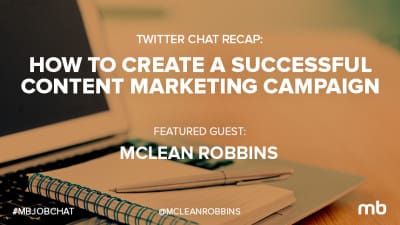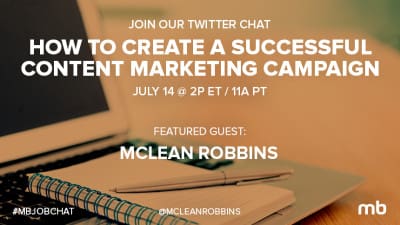Alright, so you already know about content marketing, and how it’s key to how companies and brands are telling their story, and finding new customers. You may even be looking for content marketing jobs. But do you know the all the terminology in the content marketer’s vocabulary?
These 25 content marketing terms aren’t just buzzy phrases. Read on for terms that directly correlate to content marketing success—and that belong in any modern marketing or media professional’s lexicon.
1. A/B Testing
A metrics-based evaluation, usually used to compare multiple versions of a web page or piece of content. A number of variables may be tested, including the headline, content format, layout or even the emojis in the subject line.
2. Above the Fold
Content that can be seen without scrolling down the page. This term originates from print, and describes content that was physically “above the fold” of a newspaper. Today, it refers to the top parts of a site that are most likely to catch a user’s eye.
3. Affiliate Marketing
A revenue model in which site A’s owners place ads on their site directing users to site B. Site A makes money when users click on the links and/or purchase the products. This is a common method of income generation for digital influencers (see below).
4. Aggregated (or Curated) Content
Selected content that has been sourced from other channels and put into a single site or news stream. Aggregated content is best achieved through manual curation, and authors must clearly disclose the original source of the content.
5. Black Hat
The opposite of “white hat,” this refers to individuals or firms that uses spammy or unethical techniques to try to “game” the system. Using techniques that aren’t best practice can lead to diminished search returns, penalties from search engines or even blacklisting.
6. Brand Evangelist
Individuals who have a strong positive feeling about a brand. Often brand evangelists become coveted partners of a brand and, depending on reach, may aid as influencers (there’s that word again; see it defined below) to distribute content or marketing messages in exchange for money or services.
7. Branded Content
Much like advertorials, this is content written by a brand in the style of editorial magazine or journalistic content. The content may or may not contain an overt sales push.
8. COPE
An acronym for “Create Once, Publish Everywhere,” the cornerstone of content marketing. This can also sometimes be called “atomization.” For example, one might take an e-book and break it down into a white paper, several blog posts, an infographic and a video, publishing each to different users along the content funnel and on different channels.
9. Click Bait
Catchy, often viral content that is used to capture clicks, but often has little to no journalistic value. Frequently, users who click in are disappointed by “this one surprising trick” or what you’ll “never believe” happened.
10. Content Strategy
The process of planning for and managing content creation and distribution. Content strategy is the core of content marketing.
11. Contextual Advertising
A technique used in which advertising on a given page is “in context with” other content on that page. Contextual ads feature improved click-through rates and better overall sales numbers.
12. Data Mining
Analyzing a database for purposes of extracting data about a user or users that can inform behavior. Once you understand your user base, you can use this data to create better marketing campaigns, to target specific users and behaviors and more.
13. Dynamic Content
Content that is unique to the user or group of users visiting a website. Users who visit a site regularly may see content tailored to their local area, shopping history or declared interests.
14. Earned Media
Publicity gained without paid advertising. This can be content from great posts on social media, content from journalists or editors and more. This is a core goal of content marketing—to attract qualified users via content rather than paid media.
15. Heat Map
A useful tool that can show how users interact with a page, either by showing where their eyes or their mouse travels around a website. By understanding how users engage with your website—do they like your homepage, are they ignoring your navigation—you can create better-targeted content and placement to help optimize experiences.
16. Influencer
A high-profile individual or brands in a certain space. Often, influencers have blogs or brands that align with your goals and can be used to leverage sales, commentary or visibility, thus helping to boost sales, visibility and brand recognition. Coverage by Influencers is often trusted more than regular advertisements, and can lead to higher-than-normal rates of return.
17. Lead Scoring
A marketing principle, often used in marketing automation, to assess and rank new leads and determine the likelihood that they will buy a product or service. The higher and more qualified the lead, the more likely they are to buy a product or service. Often, lead scoring combines actions completed online, such as reading a certain number of articles and blog posts on a website.
18. Marketing Automation
Tools and software that automate many marketing tasks for execution and measurement. Today’s content creators can now use these tools to directly measure the effectiveness of their content marketing campaigns, rather than simply going on “gut feel” or soft metrics like impressions.
19. Need Profiling
A gathering of customer requirements, often used by marketers who want to understand what a client hopes to gain from a project or campaign. By better understanding your customer base, you can create content that speaks more directly to your audience. You’ll not only lower costs in both labor and time, but also improve the user’s experience with the brand.
20. Newsjacking
Creating content that relates your brand and current events to drive traffic to your website or blog. Timely, relevant content not only addresses your audience’s needs, but also creates a reason for people to visit your brand now, not at some to-be-determined time in the future. Search engines also value fresh, relevant content, and may rank sites with new content more favorably.
21. Omnichannel
A rising marketing technique that puts the user in the center of many ongoing and separate yet related marketing efforts. For example, a store-goer may receive a text message alert when they are near a store, prompting a coupon or discount, receive a social media ad that they may still be interested in product X, and also receive added marketing via email and other channels.
22. Remarketing / Retargeting
An advertising strategy that allows targeted advertisements to “follow” a user and display on other online outlets after a user has visited your website. This added visibility can encourage a user to make a purchase or complete an action, thanks to ads helping your company remain top of mind.
23. Schema
A shared data markup language that makes content more accessible to search engines. When Schema is used properly, content can appear directly on top of normal search results, such as showing directions, a definition, movie times or a recipe, thus presenting users exactly the content they are looking for, when they need it most. (For more information, see Schema.org.)
24. Taxonomy
The grouping and classification of content into a hierarchy. Organizing content online is a key benefit for both search engines and users who want the best, most relevant information presented easily and effectively in a simple, single location.
25. User-Generated Content
Content contributed from individuals not paid or affiliated with a brand. Content created by users is often thought of as less biased than that created by brands, and can also help brands understand the real truth about how people use their products and services. Because UGC is not paid, it is also an economical way to build brand buzz.
McLean Robbins is a content strategist, copywriter, digital consultant and instructor of Mediabistro’s Blogging, SEO Writing and Skills in 60: Content Marketing online courses. Find her at mcleanrobbins.com.









